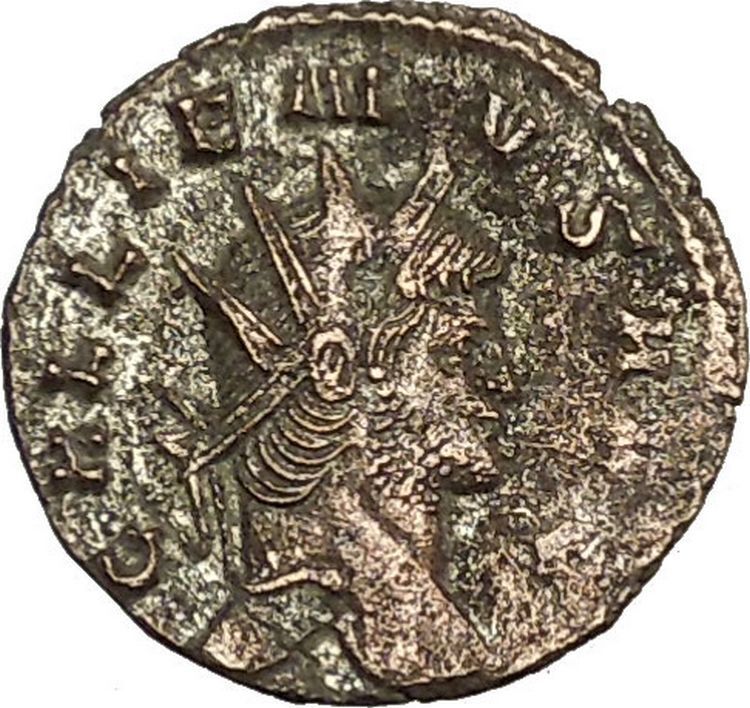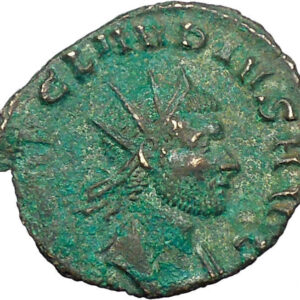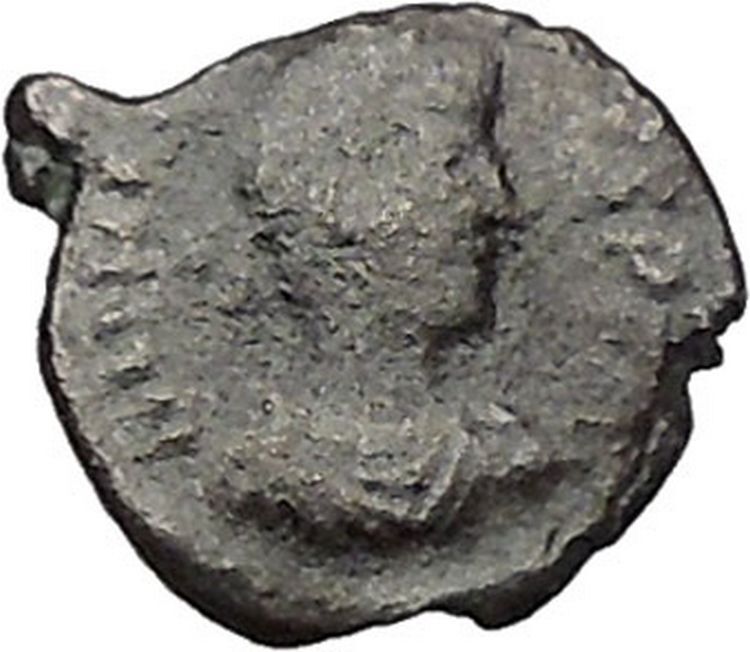|
Salonina
– Roman Empress: 253-268 A.D. – Wife of Gallienus
–
Silver Antoninianus 21mm (2.56 grams) Cologne mint. 253-268 A.D.
Reference: RIC 7 [joint reign]; RSC 115; Sear 10655.
SALONINA AVG, diademed bust right on crescent
VENVS FELIX, Venus seated left, holding sceptre, reaching for child before
her.
Venus Felix (“Lucky Venus”), her cult tile at her temple on the
Esquiline Hill
and at
Hadrian
‘s
Venus Felix et Roma Aeterna
on the
Via Sacra
. This epithet is also used for
a specific sculpture at the Vatican Museums
.
You are bidding on the exact item pictured,
provided with a Certificate of Authenticity and Lifetime Guarantee of
Authenticity.

Julia
Cornelia Salonina (d. 268,
Mediolanum
)
was an
Augusta
, wife of
Roman
Emperor
Gallienus
and mother of
Valerian
II
, Saloninus
, and
Marinianus
.
Julia Cornelia Salonina’s origin is unknown. According to a modern theory,
she was born of Greek
origin
in Bithynia
,
then part of the province of
Bithynia et
Pontus
,
Asia Minor
. However, there exists some scepticism on that.
She was married to Gallienus about ten years before his accession to the throne.
When her husband became joint-emperor with his father
Valerian
in 253, Cornelia Salonina was named Augusta.
Cornelia was the mother of three princes,
Valerian
II
, Saloninus
and
Marinianus
.
Her fate, after the murder of Gallienus, during the siege of
Mediolanum
in 268, is unknown. It is likely that either her life was spared
or the she was executed together with other members of her family, at the orders
of the Senate of Rome.
Her name is reported on coins with Latin legend as Cornelia Salonina;
however, from the Greek coinage come the names Iulia Cornelia Salonina,
Publia Licinia Cornelia Salonina, and Salonina Chrysogona
(attribute that means “begotten of gold”).
Venus is the
Roman goddess
whose functions encompassed love,
beauty,
sex
, fertility and prosperity. In
Roman mythology
, she was the mother of the
Roman people through her son,
Aeneas
, who survived the
fall of Troy
and fled to Italy.
Julius Caesar
claimed her as his ancestor.
Venus was central to many
religious festivals
, and was venerated in
Roman religion
under numerous cult titles.
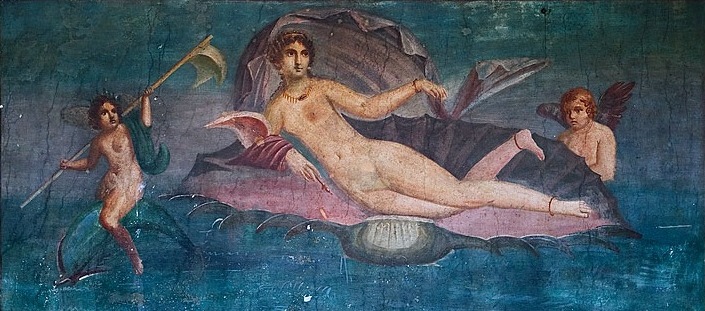
Venus on seashell, from the Casa di Venus, Pompei. Before 79 AD.
The Romans adapted the myths and iconography of her
Greek counterpart
Aphrodite
for
Roman art
and
Latin literature
. In the later
classical tradition
of
the West
, Venus becomes one of the most widely
referenced deities of
Greco-Roman mythology
as the embodiment of love
and sexuality.
Name and attributes
Trasimene
, the
Sibylline oracle
suggested that the so-called
Venus of Eryx (Venus Erycina), who belonged to Carthage’s Sicilian
allies, might be persuaded to change her allegiance. In 217 BC the Romans laid
siege to Eryx,
captured the goddess’ image
and brought it to
Rome. Once there, this “foreign Venus”, who probably combined elements of
Aphrodite and a more warlike Carthaginian-Phoenician
Astarte
, was shorn of her more overtly
Carthaginian characteristics and installed as one of Rome’s twelve
Dii consentes
in a temple on the
Capitoline Hill
. As Rome’s foundation myth made
Venus-Aphrodite the divine ancestor of the Roman people, this may have been
understood as a homecoming, rather than arrival. Rome eventually defeated
Carthage; thereafter, Venus was firmly connected both to Rome’s growing
political and military hegemony and its mythical Trojan past. Venus’ links with
Troy can be traced (via Aphrodite) to the epic, mythic history of the
Trojan War
, and the
Judgement of Paris
, in which the Trojan prince
Paris
chose Aphrodite over
Hera and Athena
, setting off a train of events that led
to war between the Greeks and Trojans, and eventually to Troy’s destruction. In
Rome’s foundation myth
, this victorious Venus
was the divine mother of the Trojan prince Aeneas, and thus a divine ancestor of
the Roman people as a whole, in her form as Venus Genetrix. Another
temple to Venus Erycina as a fertility deity was established in a
traditionally plebeian district just outside the
Colline Gate
, beyond the pomerium.
Towards the end of the Roman republic, some leading Romans laid more personal
claims to Venus’ favour.
Sulla
adopted Felix as a surname,
acknowledging his debt to heaven-sent good fortune and his particular debt to
Venus Felix, for his extraordinarily fortunate political and military
career.His protégé Pompey
competed for Venus’ favours. He
celebrated his triumph of 54 BC with coins that showed her crowned with
triumphal laurels, and built a lavishly appointed theatre and temple complex
dedicated to Venus Victrix. Pompey’s erstwhile ally and later opponent
Julius Caesar
went still further, claiming the
favours of Venus Victrix in his military success and Venus Genetrix
as a personal, divine ancestress – apparently a long-standing family tradition
among the
Julii
. Caesar’s heir,
Augustus
, adopted both claims as evidence of
his inherent fitness for office and divine approval of his rule.Augustus’ new
temple to
Mars Ultor
, divine father of Rome’s legendary
founder
Romulus
, would have underlined the point, with
the image of avenging Mars “almost certainly” accompanied by that of his divine
consort Venus, and possibly a statue of the
deceased and deified Caesar
.
The Emperor Hadrian
‘s temple to Venus and the goddess
Roma Aeterna
(Eternal Rome) made Venus the
protective genetrix of the entire Roman state, its people and fortunes.
Epithets of Venus

Imperial image of Venus suggesting influence from
Syria
or
Palestine
, or from the
cult of Isis
Like other major Roman deities, Venus was ascribed a number of
epithets
that referred to her different cult
aspects and roles. Her “original powers seem to have been extended largely by
the fondness of the Romans for folk-etymology, and by the prevalence of the
religious idea nomen-omen which sanctioned any identifications made in
this way.”
Venus
Caelestis
(Celestial or Heavenly Venus),
used from the 2nd century AD for Venus as an aspect of a syncretised supreme
goddess. Venus Caelestis is the earliest known Roman recipient of a
taurobolium
(a form of bull sacrifice),
performed at her shrine in
Pozzuoli
on 5 October 134. This form of the
goddess, and the taurobolium, are associated with the “Syrian Goddess”,
understood as a late equivalent to
Astarte
, or the Roman
Magna Mater
.
Venus Calva (“Venus the bald one”), a possibly legendary form of
Venus, attested by post Classical Roman writings which offer several traditions
to explain this appearance and epithet. In one, it commemorates the virtuous
offer by Roman matrons of their own hair to make bowstrings during a siege of
Rome. In another, king
Ancus Marcius
wife and other Roman women lost
their hair during an epidemic; in hope of its restoration, women unaffected by
the affliction sacrificed their own hair to Venus.
Venus Cloacina (“Venus the Purifier”); a fusion of Venus with the
Etruscan water goddess
Cloacina
, who had an ancient shrine above the
outfall of the
Cloaca Maxima
, originally a stream, later
covered over to function as Rome’s main sewer. The shrine contained a statue of
Venus, whose rites were probably meant to purify the culvert’s polluted waters
and noxious airs
. Pliny the Elder, remarking Venus
as a goddess of union and reconciliation, identifies the shrine with a legendary
episode in Rome’s earliest history, when the warring Romans and
Sabines
, carrying branches of myrtle, met there
to make peace.
Venus Erycina (“Venus of
Eryx
“), from
Sicily
. She was brought to Rome and given
temples on the
Capitoline Hill
and outside the
Porta Collina
. She embodied “impure” love, and
was the patron goddess of
prostitutes
.[citation
needed]
Venus Frutis honoured by all the Latins with a federal cult at the
temple named Frutinal in Lavinium.Inscrptions found at Lavinium attest
the presence of federal cults without giving precise details.
Venus Felix (“Lucky Venus”), her cult tile at her temple on the
Esquiline Hill
and at
Hadrian
‘s
Venus Felix et Roma Aeterna
on the
Via Sacra
. This epithet is also used for
a specific sculpture at the Vatican Museums
.
Venus Genetrix
(“Mother Venus”), as a
goddess of motherhood and domesticity, with a festival on September 26, and as
ancestress of the Roman people. She was claimed as direct ancestress of the
Julian
gens in particular;
Julius Caesar
dedicated a
Temple of Venus Genetrix
to her in 46 BC. This
name has attached to
an iconological type of statue of Aphrodite/Venus
.
Venus Kallipygos
(“Venus with the pretty
bottom”), worshiped at
Syracuse
.
Venus Libertina (“Venus the
Freedwoman
“), probably arising through the
semantic similarity and cultural inks between libertina (as “a free
woman”) and lubentina (possibly meaning “pleasurable” or “passionate”).
Further titles or variants acquired by Venus through the same process, or
through orthographic variance, include Libentia, Lubentina, and Lubentini.
Venus Libitina links Venus to a patron-goddess of funerals and undertakers,
Libitina
; a temple was dedicated to Venus
Libitina in Libitina’s grove on the
Esquiline Hill
, “hardly later than 300 BC.”
Venus Murcia (“Venus of the Myrtle”) was an epithet that merged the
goddess with the little-known deity
Murcia
or Murtia. Murcia was associated with
Rome’s Mons Murcia, and had a shrine in the
Circus Maximus
. Some sources associate her with
the myrtle-tree. Christian writers described her as a goddess of sloth and
laziness.
Venus Obsequens (“Graceful Venus” or “Indulgent Venus”), Venus’ first
attested Roman epithet, and used in the dedication of her first Roman temple,
sited somewhere at the foot of the
Aventine Hill
near the
Circus Maximus
. The temple was dedicated on
August 19 in the late 3rd century BC during the
Third Samnite War
by
Quintus Fabius Maximus Gurges
, and played a
central role in the
Vinalia Rustica
. It was supposedly funded by
fines imposed on women found guilty of
adultery
.
Venus Urania (“Heavenly Venus”) was an epithet used as the title of a
book by
Basilius von Ramdohr
, a relief by
Pompeo Marchesi
, and a painting by
Christian Griepenkerl
. (cf.
Aphrodite Urania
.)
Venus Verticordia (“Venus the Changer of Hearts”). See
Veneralia in this article
and
main article, Veneralia
.
Venus Victrix (“Venus the Victorious”) was an aspect of the armed
Aphrodite that Greeks had inherited from the East, where the goddess
Ishtar
“remained a goddess of war, and Venus
could bring victory to a
Sulla
or a Caesar.” Pompey, Sulla’s protégé,
vied with his patron and with Caesar for public recognition as her protégé. In
55 BC he dedicated a temple to her at the top of his
theater
in the
Campus Martius
. She had a shrine on the
Capitoline Hill
, and festivals on August 12 and
October 9. A sacrifice was annually dedicated to her on the latter date. In
neo-classical art, her epithet as Victrix is often used in the sense of ‘Venus
Victorious over men’s hearts’ or in the context of the
Judgement of Paris
(e.g.
Canova
‘s
Venus Victrix
, a half-nude reclining
portrait of
Pauline Bonaparte
).
Mythology and
literature
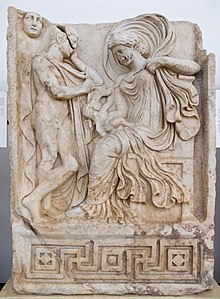
A Venus-Aphrodite
velificans
holding an infant,
probably Aeneas, as Anchises and
Luna
–Selene
look on (Roman-era relief from
Aphrodisias
)
For more details on this topic, see
Aphrodite
.
Due to her early association with
Aphrodite
in the
interpretatio graeca
, it is hard to
establish what characteristics the native Italic Venus may have had. In her
earliest forms, as a goddess of vegetation and gardens, she was commonly
associated with the Greek goddess Aphrodite and the
Etruscan deity
Turan
, borrowing aspects from each.
As with most other gods and goddesses in
Roman mythology
, the literary concept of Venus
is mantled in whole-cloth borrowings from the literary
Greek mythology
of her counterpart, Aphrodite.
In some Latin mythology
Cupid
was the son of Venus and
Mars
, the god of war. At other times, or in
parallel myths and theologies, Venus was understood to be the consort of
Vulcan
.
Virgil
, in compliment to his patron
Augustus
and the
gens Julia
, embellished an existing
connection between Venus, whom
Julius Caesar
had adopted as his protectress,
and Aeneas
. Vergil’s Aeneid has Venus lead Aeneas
to Latium
in her heavenly form, as the morning
star, shining brightly before him in the daylight sky.
In the
interpretatio romana
of the
Germanic pantheon
during the early centuries
AD, Venus became identified with the Germanic goddess
Frijjo
, giving rise to the loan translation
“Friday”
for dies Veneris. The historical cognate of the dawn goddess in Germanic
tradition, however, would be
Ostara
.
In art
Classical art
Roman and Hellenistic art produced many variations on the goddess, often
based on the
Praxitlean
type
Aphrodite of Cnidus
. Many female nudes from
this period of sculpture whose subjects are unknown are in modern art history
conventionally called ‘Venus’es, even if they originally may have portrayed a
mortal woman rather than operated as a
cult statue
of the goddess.

Venus de Milo
at the
Louvre
Art in the
classical tradition
Venus became a popular subject of
painting
and
sculpture
during the
Renaissance
period in Europe. As a “classical”
figure for whom nudity
was her natural state, it was socially
acceptable to depict her unclothed. As the goddess of
sexuality
, a degree of erotic beauty in her
presentation was justified, which appealed to many artists and their patrons.
Over time, venus came to refer to any artistic depiction in
post-classical art of a nude woman, even when there was no indication that the
subject was the goddess.

The Birth of Venus
, by
Sandro Botticelli
c. 1485–1486.
In the field of
prehistoric art
, since the discovery in 1908 of
the so-called “Venus
of Willendorf” small
Neolithic
sculptures of rounded female forms
have been conventionally referred to as
Venus figurines
. Although the name of the
actual deity is not known, the knowing contrast between the obese and fertile
cult figures
and the classical conception of
Venus has raised resistance to the terminology.
In Western art
-
Venus Anadyomene
(ca. 1525) by
Titian
-
Venus with a Mirror (ca. 1555) by
Titian
-
Birth of Venus (1863) by
Alexandre Cabanel
-
-
Russian Venus (1926) by
Boris Kustodiev
|















